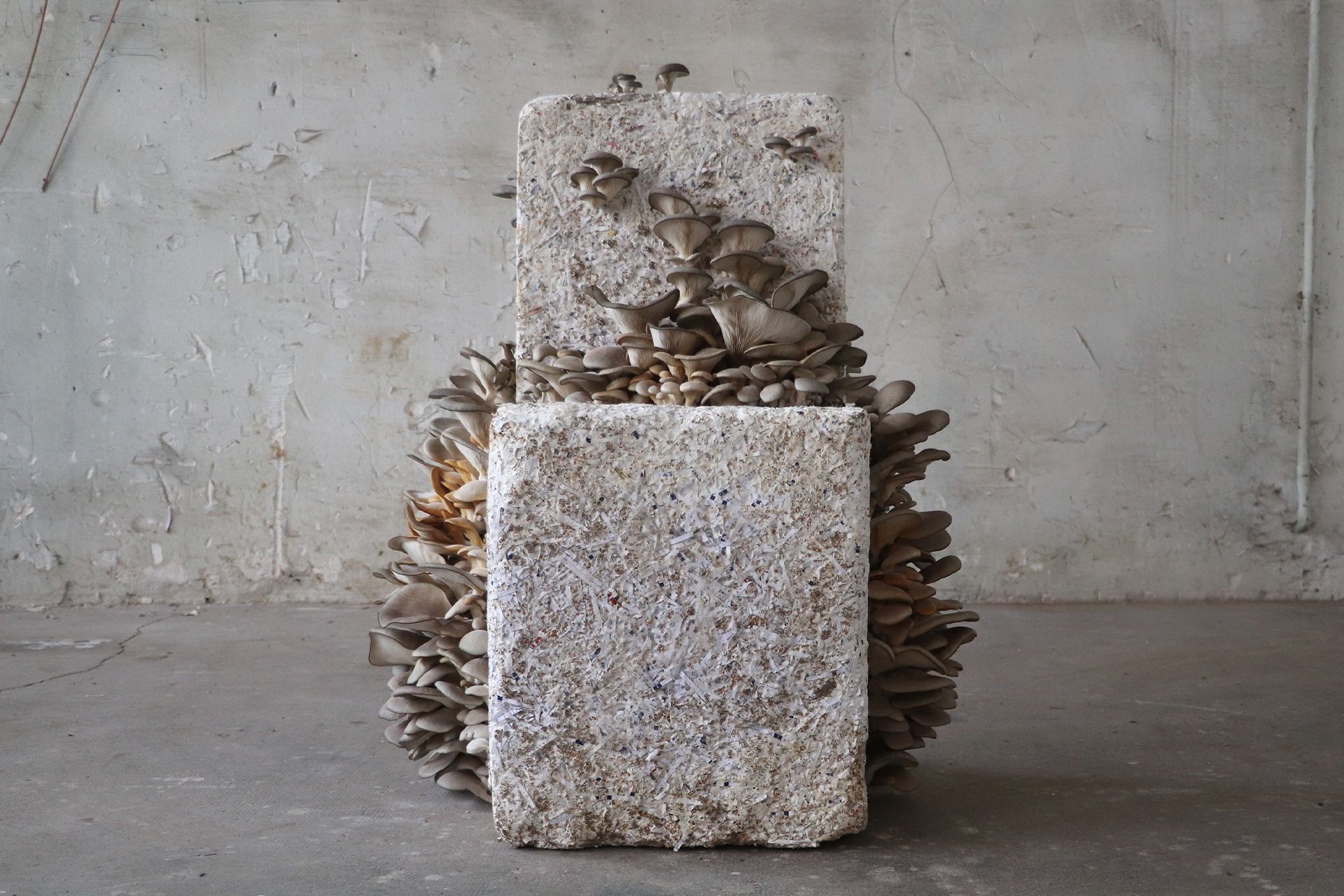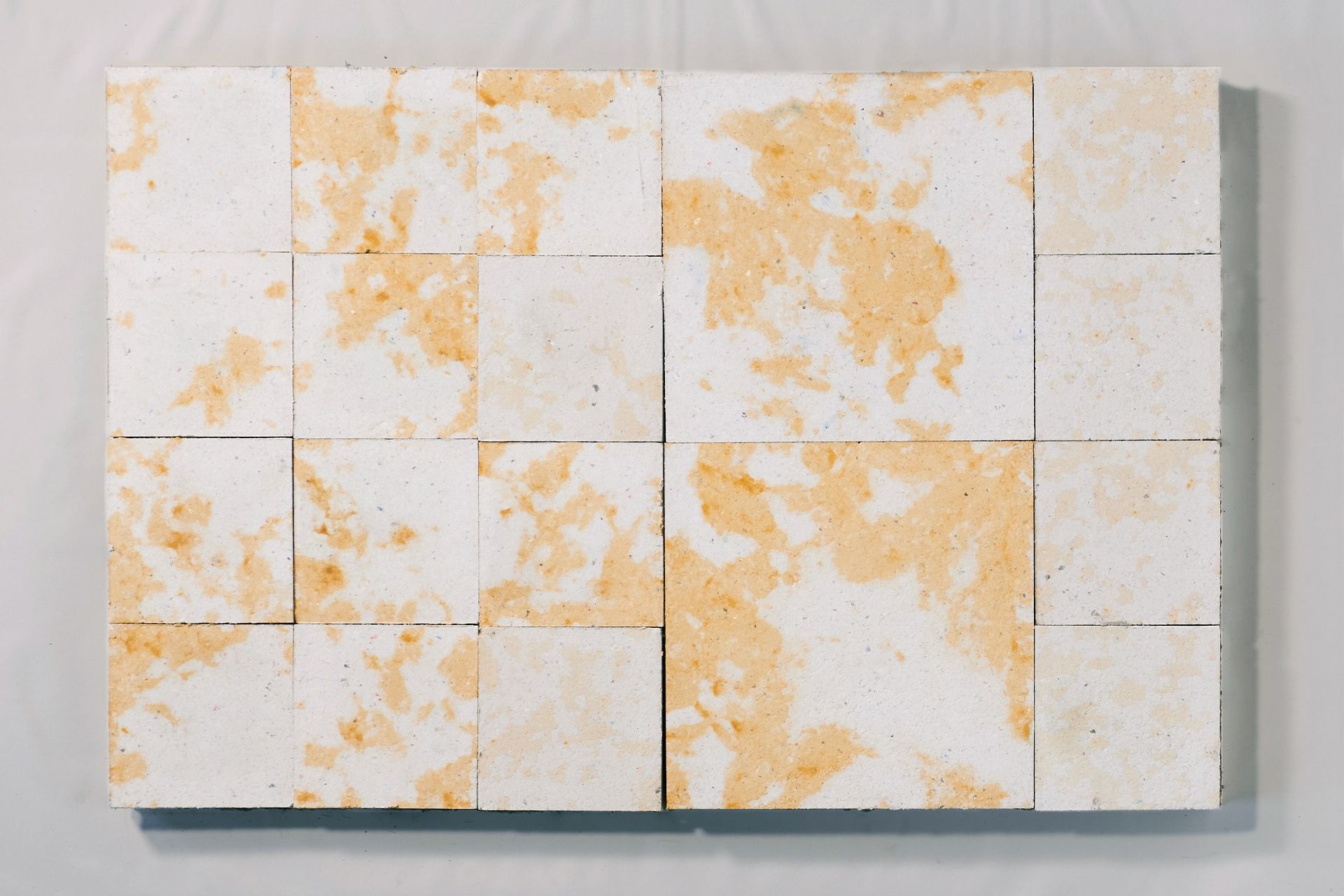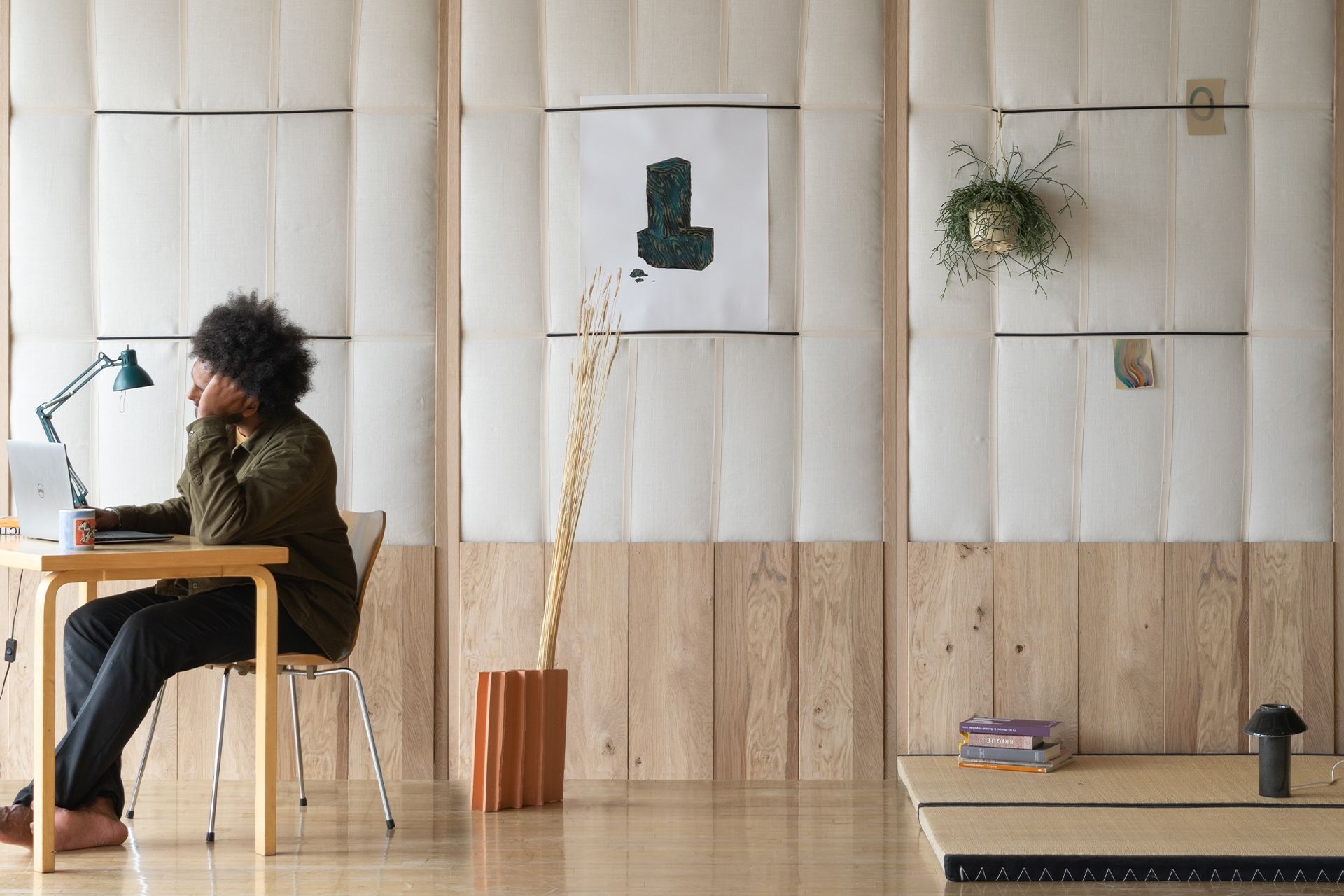Gathered in the "Living Materials" exhibition, the three design research-experiments "Wool Wall", "Back to dirt" and "Papers Tiles" innovate to bring living fabrics and inanimate objects into dialogue. Carried out by Matérial Studies, studio Aléa and Pavillon Noir Architectures with César Bazaar, the projects question production processes to reduce energy impact and resource use, thus unleashing the technical and aesthetic potential of materials derived from available organic matter.
LIVING MATERIALS
Wool Wall, Back to Dirt, Papers tiles
3 projects supported by FAIRE*
Wool Wall, Back to Dirt, Papers tiles
3 projects supported by FAIRE*
Exhibition presented from September 5 to October 1, 2023
Opening on Tuesday, September 5, 2023 at 7 pm
Opening on Tuesday, September 5, 2023 at 7 pm
Design objects have the potential to integrate living elements into their composition, form, ornamental character, and production processes. They should be developed in a manner that addresses the pressing challenges confronting our built environment. This involves exploring alternatives to resource depletion and ways to reduce the carbon footprint associated with the constructed landscape. The Matières Vivantes [Living Materials] exhibition showcases the experiments, samples, and prototypes of three innovative design projects supported by the FAIRE experimentation platform that establish a compelling dialogue between living tissue and inanimate objects through their work on minimizing the energy impact of manufacturing processes (by circumventing the need for kilning for instance) and on unlocking the technical and aesthetic potential of materials derived from readily available organic matter.
These three instances of experimental research, which were developed by Marlon Bagnou-Beido and Soufyane El Koraichi, Aléa, and Pavillon Noir Architectures alongside César Bazaar, respectively, embody a commitment to utilizing available resources, whether organic or recycled, critically reevaluating manufacturing processes and their resulting forms.
Designers Marlon Bagnou-Beido and Soufyane El Koraichi, the creative minds behind the Wood Wall project, have ingeniously harnessed wool to redefine insulation (a pivotal element in reducing aggregate heating demand) and elevate it to a full-fledged type of architectural element. Their approach stems from an examination of the transformative process from fleece to fabric and proposes interventions at three different junctures, resulting in the development of three prototypes. The first prototype is a rigid exterior insulation system that makes use of raw wool directly after shearing. The second one is a manufacturing process for easily reversible semi-rigid interior insulation panels, capitalizing on the inherent flexibility of carded sheep’s wool. The third and final prototype introduces a radiant heating surface crafted from felt and destined for shared spaces that offers to deliver energy-efficient heating that warms bodies rather than spaces.
Using the ground as a mold for cultivating mycelium—the root structure of fungi—, the founders of Aléa, designers Miriam Josi and Stella Lee Prowse, have devised a production process that embraces a “bio-inclusive” approach, treating nature as a collaborative partner, while seamlessly integrating into its environment. Under the banner of the Back to Dirt project, this process sidesteps numerous limitations associated with traditional myco-fabrication, including the need for sterilization and additional energy consumption, as well as the reliance on plastic molds. Beyond the finished product, Aléa places the spotlight on the mycelium’s remarkable ability to regenerate soils and enhance biodiversity. Using this living material, the two designers craft exhibition pieces that evolve over time, offering visitors a unique opportunity to witness the material’s ongoing transformation throughout the exhibition.
The “papers tiles” (carreaux de papier) developed by Aude Le Stum and Nicolas Bellet (the founding architects of Pavillon Noir Architectures) alongside designer and engineer César Bazaar provide a sustainable reinterpretation of cement tiles by replacing the traditional formula with a paper-based blend. In France, 9 million tons of paper are consumed annually, amounting to an average of 130 kg per capita, thus underscoring the importance of recycling this material derived from the decomposition of plant fibers. Despite being similar in size to standard concrete tiles, paper tiles achieve a 40 percent reduction in weight. Despite their lighter build, they exhibit similar compressive strength, while also being fire resistant and delivering interesting thermal and acoustic insulation properties. When combined with contemporary manufacturing techniques, paper emerges as an ideal resource for the building industry. Whether used in the form of tiles or as surface covering, paper presents a compelling opportunity to reduce the consumption of sand and cement, with the ultimate goal of replacing these materials to the maximum extent possible.
* Launched by Pavillon de l’Arsenal and the City of Paris, with the support of Caisse des Dépôts, MINI, and EDF, the FAIRE platform invites multidisciplinary teams, architects, urban planners, landscape architects, and designers to propose innovative research and experimentation projects addressing major urban challenges including climate, the materials shortage crisis, new technologies, solidarity, sanitation, and mobility. Since 2017, FAIRE has supported more than 70 multidisciplinary teams and involved upwards of a hundred stakeholders alongside winning teams in order to help develop experimental approaches.
Exhibition produced by Pavillon de l'Arsenal and presented as part of Paris Design Week and France Design Week.
Designers Marlon Bagnou-Beido and Soufyane El Koraichi, the creative minds behind the Wood Wall project, have ingeniously harnessed wool to redefine insulation (a pivotal element in reducing aggregate heating demand) and elevate it to a full-fledged type of architectural element. Their approach stems from an examination of the transformative process from fleece to fabric and proposes interventions at three different junctures, resulting in the development of three prototypes. The first prototype is a rigid exterior insulation system that makes use of raw wool directly after shearing. The second one is a manufacturing process for easily reversible semi-rigid interior insulation panels, capitalizing on the inherent flexibility of carded sheep’s wool. The third and final prototype introduces a radiant heating surface crafted from felt and destined for shared spaces that offers to deliver energy-efficient heating that warms bodies rather than spaces.
Using the ground as a mold for cultivating mycelium—the root structure of fungi—, the founders of Aléa, designers Miriam Josi and Stella Lee Prowse, have devised a production process that embraces a “bio-inclusive” approach, treating nature as a collaborative partner, while seamlessly integrating into its environment. Under the banner of the Back to Dirt project, this process sidesteps numerous limitations associated with traditional myco-fabrication, including the need for sterilization and additional energy consumption, as well as the reliance on plastic molds. Beyond the finished product, Aléa places the spotlight on the mycelium’s remarkable ability to regenerate soils and enhance biodiversity. Using this living material, the two designers craft exhibition pieces that evolve over time, offering visitors a unique opportunity to witness the material’s ongoing transformation throughout the exhibition.
The “papers tiles” (carreaux de papier) developed by Aude Le Stum and Nicolas Bellet (the founding architects of Pavillon Noir Architectures) alongside designer and engineer César Bazaar provide a sustainable reinterpretation of cement tiles by replacing the traditional formula with a paper-based blend. In France, 9 million tons of paper are consumed annually, amounting to an average of 130 kg per capita, thus underscoring the importance of recycling this material derived from the decomposition of plant fibers. Despite being similar in size to standard concrete tiles, paper tiles achieve a 40 percent reduction in weight. Despite their lighter build, they exhibit similar compressive strength, while also being fire resistant and delivering interesting thermal and acoustic insulation properties. When combined with contemporary manufacturing techniques, paper emerges as an ideal resource for the building industry. Whether used in the form of tiles or as surface covering, paper presents a compelling opportunity to reduce the consumption of sand and cement, with the ultimate goal of replacing these materials to the maximum extent possible.
* Launched by Pavillon de l’Arsenal and the City of Paris, with the support of Caisse des Dépôts, MINI, and EDF, the FAIRE platform invites multidisciplinary teams, architects, urban planners, landscape architects, and designers to propose innovative research and experimentation projects addressing major urban challenges including climate, the materials shortage crisis, new technologies, solidarity, sanitation, and mobility. Since 2017, FAIRE has supported more than 70 multidisciplinary teams and involved upwards of a hundred stakeholders alongside winning teams in order to help develop experimental approaches.
Exhibition produced by Pavillon de l'Arsenal and presented as part of Paris Design Week and France Design Week.



PROJECT LEADERS
Marlon Bagnou Beido et Soufyane El Koraichi
Marlon Bagnou Beido (founder of the studio Warm Weekend) and Soufyane El Koraichi are two Paris-based industrial designers. Both graduates of ENSCi—Les Ateliers, they share a common interest in developing new types of objects addressing the issues of thermal comfort, resource management, and, more broadly, of energy use.
Aléa - Miriam Josi et Stella Lee Prowse
Aléa is an experimental design and material research studio based in Paris. Miriam Josi (from Switzerland) and Stella Lee Prowse (from Australia) cofounded Aléa in 2021 after both completing a Master’s degree in Nature-Inspired Design at ENSCi - Les Ateliers Paris. Their work employs the process of growth and decay while challenging prevailing notions of waste and resource, material temporalities, value, ethics and aesthetics. Aléa’s practice is situated at the intersections of design, biology, and agriculture, blurring the boundaries between disciplines.
César Bazaar
Operating from his creative laboratory and innovative fabrication workshop in Pantin, César Bazaar’s primary focus is on cement tiles. By integrating sustainable materials, local resources, and reclaimed materials, César strives to redefine manufacturing processes and reimagine how materials are utilized.
Pavillon Noir Architectures - Nicolas Bellet and Aude Le Stum
After spending several years working in Parisian studios, Aude and Nicolas partnered together to create Pavillon Noir Architectures in June 2021. The firm was founded on a shared passion for challenging conventional norms and leveraging preexisting conditions to question both the environment and materiality.



